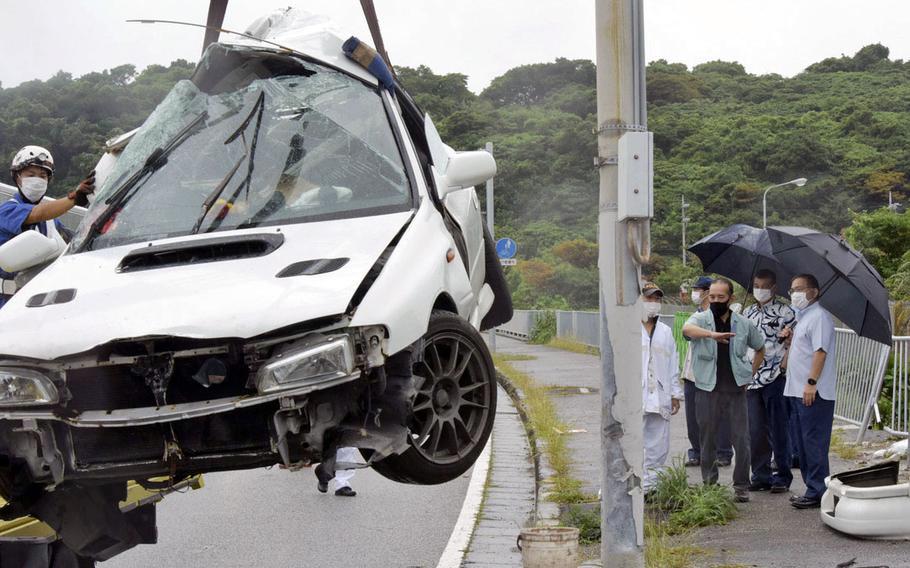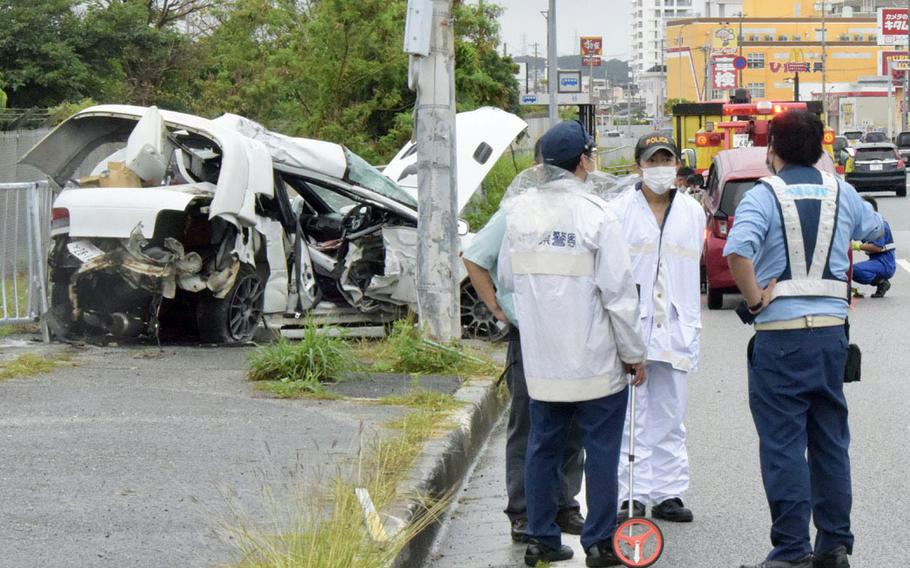Asia-Pacific
US military, Japanese police urge safe driving ahead of annual traffic safety campaign
Stars and Stripes May 10, 2023

A U.S. Marine was killed May 14, 2022, after his car veered off Route 58 and crashed into a light pole and pedestrian fence outside Camp Foster, Okinawa. (Frank Andrews/Stars and Stripes)
YOKOTA AIR BASE, Japan — Motor vehicle accidents on Japan’s streets, highways and expressways are on the rise and traffic cops are on alert, Japanese and U.S. military authorities warned recently.
“Vehicle accidents are a leading cause of preventable injuries, and driving in Japan is different than driving in the United States,” Air Force Lt. Gen. Ricky Rupp, commander of US Forces Japan, wrote in an April 19 letter to all troops serving in the country.
Distracted driving, bad weather, impairment and aggressive driving are contributing to a rise in accidents on the nation’s roadways, Rupp’s letter states, though it provided no data to reinforce the claim.
A representative for USFJ in an unsigned email May 2 said the command did not have accident statistics involving U.S. personnel in Japan and referred Stars and Stripes to the individual service branches for that information.
Stars and Stripes on May 3 contacted III Marine Expeditionary Force, U.S. Army Japan and Naval Forces Japan, whose spokespeople referred the question back to USFJ. An Air Force spokesman, Allen Gutierrez, did not respond.
Rupp issued his message to bring fresh attention to safe driving as the lifting of COVID-19 measures in Japan results in increased travel, USFJ spokeswoman Yukiko Date said in an email Wednesday.
Japan’s annual Spring Traffic Safety campaign starts Thursday and continues until May 20. It typically includes stepped-up traffic enforcement and an increased police presence.

A U.S. Marine was killed May 14, 2022, after his car veered off Route 58 and crashed into a light pole and pedestrian fence outside Camp Foster, Okinawa. (Frank Andrews/Stars and Stripes)
By March 31, Japan had experienced more than 73,000 reported accidents, a 4.5% increase over the same period in 2022, according to a March report from the National Police Agency. Those accidents resulted in more than 83,000 injuries and 600 fatalities.
Last year, failure to adhere to safe driving practices accounted for about 198,000 incidents, over half of all reported accidents, according to the agency’s 2022 annual report. Japan defines violations of safe driving practices as distracted driving, speeding and reckless driving.
Causing a traffic accident that results in injury in Japan can carry a maximum sentence of seven years in prison and fines up to about $7,400. Causing injury or death in a traffic accident may also result in substantial payments to surviving family members or injured parties to make amends for their suffering, a common practice in Japan.
Officers and senior noncommissioned officers must ensure their troops understand the risks on Japanese roads and the importance of driving safely both on and off duty, Rupp wrote in his safety letter.
“Leaders must ensure newly arrived personnel to Japan take their initial driving instructions and tests seriously,” he said.
In Japan, vehicles must be covered by Japanese Compulsory Insurance, or JCI, liability insurance that covers the death or injury of crash victims. Driving without mandated insurance is a criminal offense.
Drivers under the status of forces agreement are also required to have minimum coverage for vehicle damage. SOFA covers the rights and responsibilities of people in Japan with the U.S. military.
Japan’s spring safety campaign has three objectives, according to the Cabinet Office: securing safety for pedestrians, especially children; raising awareness of safe driving and accident prevention; and ensuring bicyclists obey traffic laws and wear helmets.
Fatal accidents involving pedestrians are rising compared to last year, according to an April 27 news release from Japan’s National Police Agency. Drivers are most often at fault, but pedestrians are at fault 25% of the time, the agency said.
Accidents involving bicycles are higher again for the second year in a row. According to the release, 40% of fatal accidents occur at intersections and 60% of cyclists who died in an accident sustained a head injury. The death rate is about 2.6 times greater for bicyclists not wearing helmets.